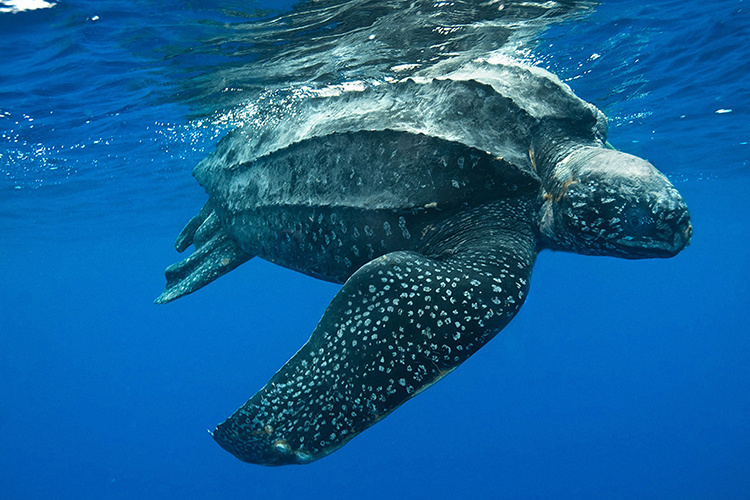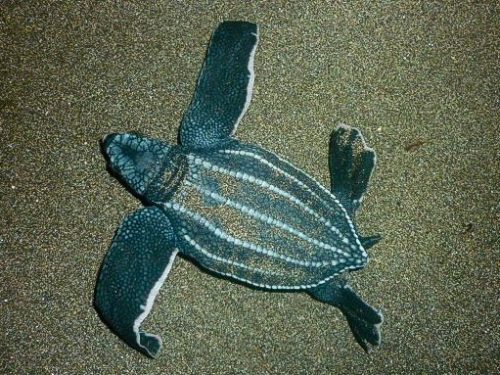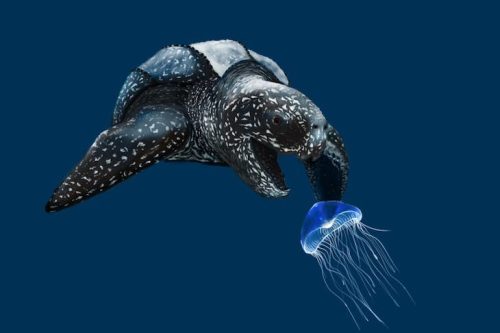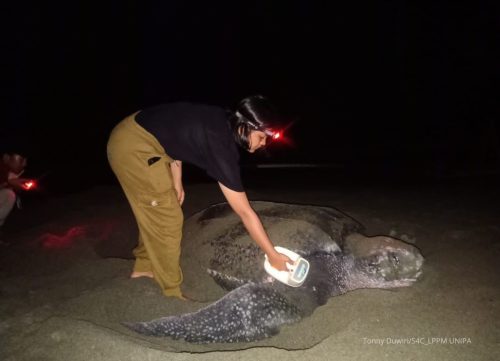Leatherback Turtle: The Gentle Sea Giant Introduction

Photo Credit : NOAA Fisheries
The Leatherback Turtle (Dermochelys coriacea) is a type of giant turtle and the only species of the Dermochelyidae family that is still alive. Known as the largest turtle in the world, the Leatherback Turtle is the fourth largest reptile in the world after three types of crocodiles. In Indonesia, leatherback turtles are commonly found in the Bird’s Head region of Papua, Jamursbamedi beach.
Distinctive Features of the Leatherback Turtle
The Leatherback Turtle has distinctive features that set it apart from other turtles. Its carapace is shaped like the lines on a starfruit, not covered by bone, but only covered by skin and oily flesh. The texture of its carapace is like skin/rubber and does not have scales like most turtles. The head of the leatherback turtle is small, round and without any scales. The color of the adult turtle’s carapace is blackish or dark brown.

Photo Credit : IDN Times
The Leatherback Turtle is also considered a home for several organisms. Small aquatic creatures, often referred to as epibionts, frequently attach themselves to hard surfaces such as the turtle’s shell. The turtle also helps build marine habitats by spreading these epibionts. In the open sea, kilometres away from the shore, the turtle also serves as an oasis for birds and fish. The turtle provides a place for rest, foraging, and even a refuge from predators.
Size and Speed
The Leatherback Turtle is larger in size compared to other types of turtles, such as the green turtle, hawksbill turtle, and loggerhead turtle. Its body length reaches up to 2.7 meters and its body weight can reach up to 900 kg. Not only that, the Leatherback Turtle also has a pair of front limbs in the form of paddles (flippers) that grow up to 2.7 meters. This turtle moves very slowly on dry land, but when swimming, it is the fastest reptile in the world with speeds reaching 35 km per hour.
Diet and Behavior
The Leatherback Turtle, known as the largest species of turtle, has a diet that primarily consists of jellyfish. This marine creature plays a crucial role in controlling the population of jellyfish in the ocean. Their unique body structure, including a throat lined with backward-pointing spines, allows them to easily consume and digest their gelatinous prey. However, this dietary preference also exposes them to the risk of consuming plastic debris, which can be mistaken for jellyfish, leading to harmful health effects and often, their untimely death. Therefore, the Leatherback Turtle’s feeding habits not only highlight its unique biological adaptations but also underscore the broader environmental issue of oceanic plastic pollution

Photo Credit : AVETPHOTOS Shutterstock
Threats and Conservation Efforts
Despite being protected by domestic and international regulations, the reality is that the existence of turtles in the ocean, especially in the open sea, is still threatened. In addition to hunting and trading, another factor contributing to the extinction of turtles in Indonesia is plastic waste. Turtles often die because they get caught in nets and because they eat plastic garbage. Various turtle conservation efforts have been carried out by several parties, including the Nagaraja Turtle Conservation Community, the Sukabumi Pangumbahan Turtle Conservation, and the Aceh Besar District Turtle Conservation Community.

Photo Credit : Science4Conservation
Conclusion
The Leatherback Turtle is a sea treasure that we need to protect. With its size and speed, this turtle demonstrates the strength and beauty of nature. However, they also face serious threats and need our protection. Let’s do our part to help preserve this extraordinary species.

